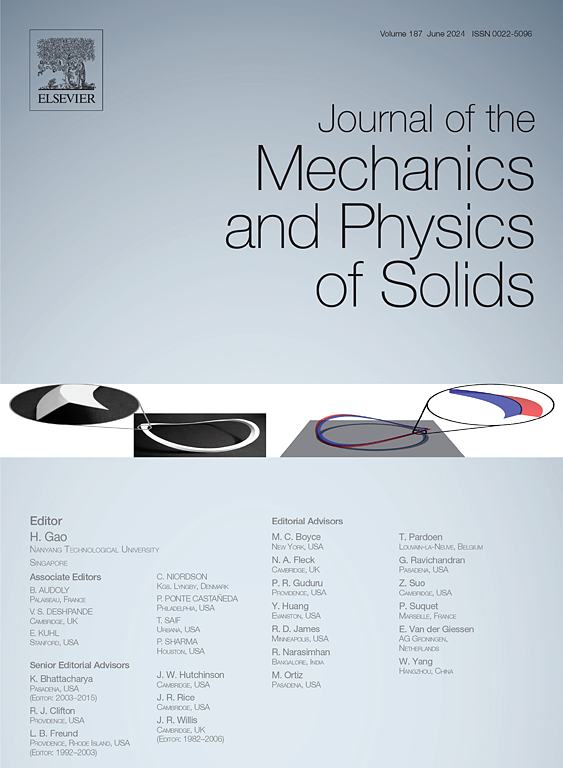Minimizing finite viscosity enhances relative kinetic energy absorption in bistable mechanical metamaterials but only with sufficiently fine discretization: A nonlinear dynamical size effect
IF 5
2区 工程技术
Q2 MATERIALS SCIENCE, MULTIDISCIPLINARY
引用次数: 0
Abstract
Bistable mechanical metamaterials have shown promise for mitigating the harmful consequences of impact by converting kinetic energy into stored strain energy, offering an alternative and potentially synergistic approach to conventional methods of attenuating energy transmission. In this work, we numerically study the dynamic response of a one-dimensional bistable metamaterial struck by a high speed impactor where the impactor velocity is commensurate with the sound speed, using the peak kinetic energy experienced at midpoint of the metamaterial compared to that in an otherwise identical linear system as our performance metric. We make five key findings: (1) The bistable material can counter-intuitively perform better (to nearly better than the linear system) as the viscosity decreases but remains finite, however this only occurs when sufficiently fine discretization has been reached (i.e. the system approaches sufficiently close to the continuum limit); (2) This discretization threshold is sharp, and depends on the viscosity present; (3) The bistable materials can also perform significantly worse than linear systems (for low discretization and viscosity or zero viscosity); (4) The dependence on discretization stems from the partition of energy into trains of solitary waves that have pulse lengths proportional to the unit cell size, where, with intersite viscosity, the solitary wave trains induce high velocity gradients and thus enhanced damping compared to linear, and low-unit-cell-number bistable, materials; and (5) When sufficiently fine discretization has been reached at low viscosities, the bistable system consistently outperforms the linear one for a wide range of impactor conditions, without impact condition regions of underperformance. The first point is particularly important, as it shows the existence of a nonlinear dynamical “size effect”, where, given a protective layer of some thickness and otherwise identical quasi-static mechanical properties and total mass, e.g., a thick layer having 200 unit cells of 5 thickness is predicted to perform significantly better than one having 20 unit cells of 50 thickness. The complex dynamics revealed herein could help guide the future design and application of bistable, and perhaps more generally nonlinear, metamaterials in various domains including signal processing, shape changing devices, and shock and impact protection, with particular benefits in the latter case predicted for scenarios where constituent materials with low intrinsic viscosity are needed (e.g., wherein metals or ceramics would be used).

最小化有限粘度提高双稳态机械超材料的相对动能吸收,但只有在足够精细的离散化下:非线性动态尺寸效应
双稳态机械超材料有望通过将动能转化为存储的应变能来减轻冲击的有害后果,为传统的衰减能量传输方法提供了一种替代方法和潜在的协同方法。在这项工作中,我们数值研究了一维双稳态超材料被高速冲击器撞击时的动态响应,其中冲击器的速度与声速相称,使用在超材料中点经历的峰值动能与在其他相同线性系统中的峰值动能相比较作为我们的性能指标。我们得出了五个关键发现:(1)当粘度降低但仍然有限时,双稳态材料可以反直觉地表现得更好(比线性系统好近103倍),然而这只有在达到足够精细的离散化时才会发生(即系统接近连续统极限);(2)该离散化阈值是尖锐的,并且取决于存在的粘度;(3)双稳态材料的性能也明显差于线性系统(低离散化和粘度或零粘度);(4)对离散化的依赖源于能量被分割成脉冲长度与单元尺寸成正比的孤立波序列,其中,具有间隙粘度的孤立波序列诱导高速度梯度,因此与线性和低单元数双稳态材料相比,阻尼增强;(5)当在低粘度下达到足够精细的离散化时,双稳态系统在大范围的冲击条件下始终优于线性系统,而不会出现性能不佳的冲击条件区域。第一点特别重要,因为它显示了非线性动态“尺寸效应”的存在,其中,给定一定厚度的保护层和其他相同的准静态机械性能和总质量,例如,预测具有200个5 μm厚度的单元格的1mm厚层的性能明显优于具有20个50 μm厚度的单元格的保护层。本文揭示的复杂动力学可以帮助指导双稳态,也许更普遍的非线性,超材料在各个领域的设计和应用,包括信号处理,形状改变装置,冲击和冲击保护,特别是在后一种情况下,预测需要低特性粘度的成分材料(例如,其中将使用金属或陶瓷)。
本文章由计算机程序翻译,如有差异,请以英文原文为准。
求助全文
约1分钟内获得全文
求助全文
来源期刊
CiteScore
9.80
自引率
9.40%
发文量
276
审稿时长
52 days
期刊介绍:
The aim of Journal of The Mechanics and Physics of Solids is to publish research of the highest quality and of lasting significance on the mechanics of solids. The scope is broad, from fundamental concepts in mechanics to the analysis of novel phenomena and applications. Solids are interpreted broadly to include both hard and soft materials as well as natural and synthetic structures. The approach can be theoretical, experimental or computational.This research activity sits within engineering science and the allied areas of applied mathematics, materials science, bio-mechanics, applied physics, and geophysics.
The Journal was founded in 1952 by Rodney Hill, who was its Editor-in-Chief until 1968. The topics of interest to the Journal evolve with developments in the subject but its basic ethos remains the same: to publish research of the highest quality relating to the mechanics of solids. Thus, emphasis is placed on the development of fundamental concepts of mechanics and novel applications of these concepts based on theoretical, experimental or computational approaches, drawing upon the various branches of engineering science and the allied areas within applied mathematics, materials science, structural engineering, applied physics, and geophysics.
The main purpose of the Journal is to foster scientific understanding of the processes of deformation and mechanical failure of all solid materials, both technological and natural, and the connections between these processes and their underlying physical mechanisms. In this sense, the content of the Journal should reflect the current state of the discipline in analysis, experimental observation, and numerical simulation. In the interest of achieving this goal, authors are encouraged to consider the significance of their contributions for the field of mechanics and the implications of their results, in addition to describing the details of their work.

 求助内容:
求助内容: 应助结果提醒方式:
应助结果提醒方式:


